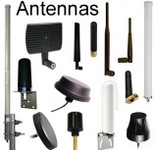Antennas, Antenna Cables, Wireless Products: Technical Articles
LPWAN Technologies: LoRaWAN and Sigfox Compared
Comparison of the two leading LPWAN technologies
In the growing Internet of Things (IoT) ecosystem, the need for long-range, low-power communication solutions is increasingly evident. Two leading Low-Power Wide-Area Network (LPWAN) technologies that have emerged to address this requirement are LoRaWAN and Sigfox. Both offer unique advantages and limitations. In this article, we will delve into a comparative analysis between the two.

LoRaWAN: LoRaWAN is a protocol built on top of the LoRa (Long Range) physical layer. It operates in the sub-gigahertz frequency spectrum and is designed for long-range, low-power communications.

Sigfox: Sigfox is a proprietary communication solution that also operates in the sub-gigahertz range. It was one of the first LPWAN technologies introduced to the market and is built to serve devices that send infrequent, small bursts of data.
Technical Differences
Bandwidth and Data Rate:
- LoRaWAN: Offers adjustable data rates using different spreading factors, providing a balance between range and data rate. It can achieve data rates from 0.3 kbps to 50 kbps.
- Sigfox: Has a fixed data rate of 100 bps, which is considerably lower, catering primarily to devices transmitting small amounts of data.
Message Size and Frequency:
- LoRaWAN: Allows payload sizes up to 243 bytes per message. The number of messages one can send varies by region due to regulatory restrictions, but typically it can be up to several messages per hour.
- Sigfox: Limits payload size to 12 bytes per message and up to 140 messages per day.
Architecture and Coverage:
- LoRaWAN: Operates on a star-of-stars topology with gateways relaying messages from end devices to a central network server. Coverage is often determined by the presence of gateways, making it suitable for both public and private deployments.
- Sigfox: Uses a simple star network where devices communicate directly with Sigfox base stations. Coverage is provided by Sigfox and is thus dependent on their infrastructure rollout in a particular region.
Security:
- LoRaWAN: Incorporates end-to-end encryption using AES-128, with separate keys for the network and application layers.
- Sigfox: Employs a proprietary encryption mechanism, but due to its shorter message size, the effective encryption can be argued to be weaker than that of LoRaWAN.
Interference and Scalability:
- LoRaWAN: Has built-in resistance to interference and is highly scalable due to its ability to leverage multiple channels and spreading factors.
- Sigfox: Uses a narrowband approach which inherently provides resistance to interference but may face scalability challenges in densely populated device environments.
Market and Ecosystem
- LoRaWAN: The open nature of LoRaWAN has fostered a large community and ecosystem. The LoRa Alliance, which manages the protocol, consists of numerous companies working together to standardize and promote the technology.
- Sigfox: Being proprietary, Sigfox controls its ecosystem more tightly. However, they've established partnerships with various device manufacturers and solution providers, ensuring a diverse range of Sigfox-ready devices in the market.
Final Thoughts
Both LoRaWAN and Sigfox have their own merits and are tailored for specific use cases. While LoRaWAN offers more flexibility in terms of data rate and payload size, it requires more sophisticated network management. Sigfox, on the other hand, simplifies connectivity at the cost of lower data rates and shorter message sizes.
The choice between the two largely depends on the specific requirements of an IoT deployment. Considerations should be given to factors like data volume, frequency of transmissions, coverage needs, scalability, and ecosystem support.







